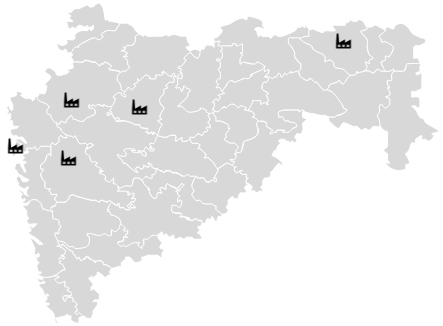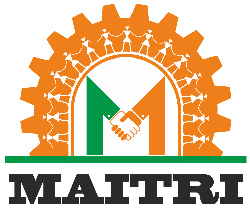Auto and Auto Component
1. State Profile (common across all sectors):
- The state ranks 2nd by population and 3rd by geographical area.
- As per 2011 census, Maharashtra had a population of 112 crs. having a literacy rate of 82.3% and a sex ratio of 929 (Females over per thousand males).
- It is one of the highly urbanized states of India having density of population as 365 (per sq. km).
- Maharashtra is India’s largest state economy contributing ~15% to India’s GDP.
- State is an Industrial Power House, contributing ~15.5% of India’s manufacturing, and ~15.7% of exports from the country.
-
Maharashtra’s logistics & infrastructure profile includes:
- 720 kms long coastline covered by 2 major (JNPT & MBPT) and 48 non-major ports
- National Highways (18,366 kms) and state highways (30,465 kms); ~99.2% of villages are connected in the state
- Railway length of ~11,631 kms capturing 9% of country’s railway network
- 4 international and 8 domestic airports are operational along with 2 upcoming airports at Navi Mumbai and Pune (Purandar)
- State ranks 2nd in terms of electricity generation installed capacity
- 2.23 MMTPA of warehousing capacity along with 1.03 MMTPA of cold storage capacity
- The state boasts 292 industrial areas, 99 co-operative industrial estates, along with dedicated sectoral parks spread over 2.5 lakh acres land. In addition, state also has dedicated wine parks, silver parks, 9 SEZs, floriculture parks, food parks, textile parks and 27 IT parks.
2. Sector Highlights
India Level:
- GDP – The auto sector contributes to around 7.1% of the GDP of India generating employment to nearly 37 million people while the auto components sector contributes to 2.5% of GDP of India generating employment to nearly 5 million people.
- FDI – The FDI inflow is around USD 36.65 billion from Apr 2000 to June 2024 contributing to around 5.27% of the total FDI inflows in India.
- Exports – 4.7% share in India’s exports.
- Rankings – India is 2nd largest manufacturer of three-wheeler. Among the top 2 manufacturer of two-wheeler in the world. Among the top 4 manufacturers of passenger vehicles. Among the top 5 manufacturers of commercial vehicles.
Maharashtra Level:
- GSDP – The sector contributes 7% of the state GSDP while 15.3% to the industrial GSDP.
- Output – The state contributes 23% to the country’s auto and auto components sector output. Share in India’s output – 23% for motor vehicles, 20% for bodies for motor vehicles, manufacturing of trailers & semi-trailers, 23% for parts and accessories.
- GVA – The state contributes 23% to the country’s auto and auto components GVA.
- Around 95% of the automotive industry is concentrated in 5 industrial cluster namely Pune, Mumbai, Nashik, Aurangabad and Nagpur.
-
Pune has more than 4,000 automotive units, making it has the largest auto hub of India. While the state has more than 10,000 units engage in auto and auto components manufacturing.

- The state has 3 dedicated institutes for automotive sector – Automotive Research Association of India – for automotive R&D, testing and certification in Pune, Auto Cluster Development and Research Institute – for development of MSMEs to meet expectations of OEMs and Horiba India Technical Centre in Pune – for emission measurement systems and advanced analytical instruments.
- The state has a dedicated Maharashtra EV Policy 2021 aimed to develop robust electric vehicle manufacturing and R&D ecosystem related to electric vehicle in Maharashtra.
3. Vision, Mission, Objectives
Vision
- 1. Adoption of sustainable and clean mobility solutions in Maharashtra.
- 2. Transform Maharashtra into a leading state in terms of adoption of electric vehicles in the country.
- 3. Retain Maharashtra’s leadership in automotive manufacturing in India.
Mission
- 1. To bring a transition in the transportation ecosystem of Maharashtra by creating demand for the purchase and use of EV in the state through demand-side initiatives.
- 2. To stimulate manufacturing of electric vehicles in the state through set of supply side initiatives that aim to attract investments, facilitate the establishment of manufacturing units, and encourage the production of EV, EV components including Advanced Chemistry Cell (ACC) batteries, EV vehicle supply equipment (EVSE) and recycling industry.
Objectives
- The primary objective of the Maharashtra EV policy is to accelerate adoption of Battery Electric Vehicle (BEVs) in the state so that they contribute to 10% of new vehicle registrations by 2025.
- In the six targeted urban agglomerations i.e. Mumbai, Pune, Nagpur, Nashik, Aurangabad and Amravati in the state, achieve 25% electrification of public transport, fleet aggregators and last mile delivery vehicles by 2025.
- Transition of 15% of Maharashtra State Road Transport Corporation (MSRTC) existing bus fleet to electric.
- Make Maharashtra the country’s top producer of BEVs in India, in terms of annual production capacity.
- Target establishment of at least one Gigafactory for the manufacturing of advanced chemistry cell (ACC) batteries in the state.
- Promote R&D, innovation and skill development across the EV ecosystem in the state.
Policy Initiatives and Incentives
The Maharashtra EV Policy provides several demand-side incentives aimed at encouraging EV adoption across various segments.
- Incentives based on battery capacity per vehicle
- Buyers who purchased EVs before Dec 31, 2021 received an additional incentive of Rs. 5000 per kWh capped at Rs. 1,00,000
- Vehicles eligible for demand incentives can receive scrappage incentive upon scrapping their Internal Combustion Engine (ICE) vehicle.
- Additional incentives are offered for assured buyback and battery warranties.
- Other demand incentives include tax and free exemptions, single time incentive per category, financial support, registration and permits.
- Incentives on charging stations. Other incentives include property tax rebates, city charging plans, use of FCC Grants, parking and lane preferences, free parking for Evs, etc.
The Maharashtra EV Policy provides several supply-side incentives aimed at encouraging EV adoption across various segments.
- Investment in EV Manufacturing and R&D – Maharashtra provides incentives for EV component and battery manufacturing, assembly, recycling, and R&D facilities, with benefits across the state similar to ‘D+’ mega projects.
- PLI Scheme for Battery Manufacturing – Maharashtra provides incentives for EV component and battery manufacturing, assembly, recycling, and R&D facilities, with benefits across the state similar to ‘D+’ mega projects.
- Vehicle Scrapping and Battery Disposal – The state plans a ‘State Scrapping Policy’ for eco-friendly vehicle disposal and guidelines for safe EV battery handling, to be managed by the Transport Department.
Enabling Ecosystem (Wizard, Incentive Calculator, Single Window, MAITRI Cell)
Key Players in the State

Key Contacts in the State
Shri Jitendra Patil – Add. Transport Commissioner
022-22614723
adtc.tpt-mh@gov.in



